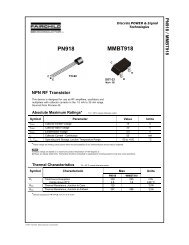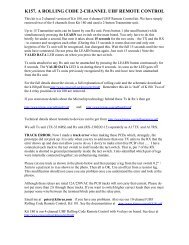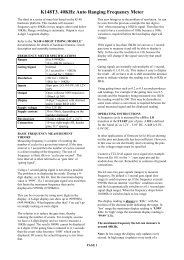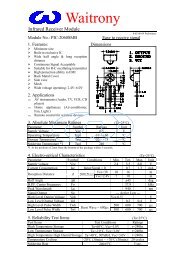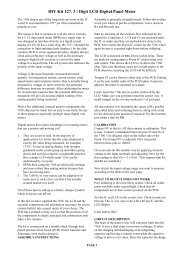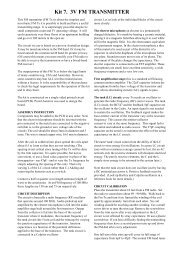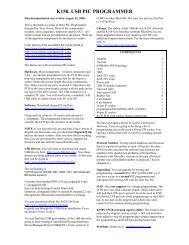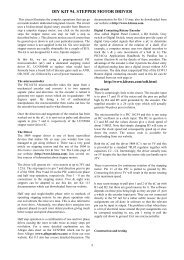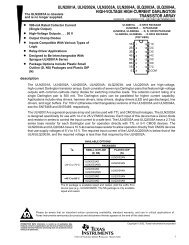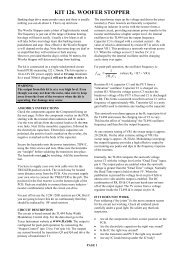Kit 18. 9V FM TRANSMITTER - Kitsrus
Kit 18. 9V FM TRANSMITTER - Kitsrus
Kit 18. 9V FM TRANSMITTER - Kitsrus
Create successful ePaper yourself
Turn your PDF publications into a flip-book with our unique Google optimized e-Paper software.
<strong>Kit</strong> <strong>18.</strong> <strong>9V</strong> <strong>FM</strong> <strong>TRANSMITTER</strong><br />
This transmitter (Tx) has been developed as a more<br />
powerful yet simpler version of <strong>Kit</strong> 7. Component count has<br />
been reduced yet the power has been increased by using a<br />
<strong>9V</strong> battery. The tank oscillator coil has been incorporated<br />
into the PCB trackwork itself. A bigger tuning film<br />
capacitor has been used to get more fine tuning anywhere<br />
in the <strong>FM</strong> band.<br />
It has a greater range which is mainly the result of its higher<br />
operating voltage. The output power of this <strong>FM</strong> Tx is<br />
below the legal limits of many countries.<br />
The kit is constructed on a single-sided printed circuit<br />
board (PCB). A computer aided design program, Protel for<br />
DOS, was used to design the board.<br />
ASSEMBLY INSTRUCTIONS<br />
Surface Mount Resistors. We have included 5 surface<br />
mount (SM) resistors as well as the normal, through-hole<br />
resistors. You are invited to try to solder the surface mount<br />
components first. If you fail then you can still use the<br />
normal components and the kit will not be ruined. The<br />
value is written on the resistor itself - 101 102 123 205<br />
The pads for the SM components are on the solderside of<br />
the PCB. Identify the resistor value from the overlay then<br />
try to solder the SM resistor on the pads underneath. There<br />
are 5 SM resistors. If you make a mess and cannot do it<br />
then just use the normal through-hole resistors which are<br />
also supplied.<br />
Try to add the SM resistors first. Then follow with the<br />
other components. The electret microphone should be<br />
inserted with the pin connected to the metal case<br />
connected to the negative rail (that is, to the ground or zero<br />
voltage side of the circuit.) This is marked with a '-' sign at<br />
the MIC on the overlay of the circuit board.<br />
The battery snap must be connected with the Red lead<br />
going to the <strong>9V</strong>+ pad and the Black lead going to the '-' or<br />
ground rail. Adding and removing the batteries acts as a<br />
switch for the Tx. Use some of the metal wire cut off the<br />
other components to add the LINK at the place indicated<br />
on the circuit board.<br />
Connect a half or quarter wavelength length of wire to the<br />
aerial point. At an <strong>FM</strong> frequency of 100 MHz these lengths<br />
are 150 cm and 75 cm respectively.<br />
CIRCUIT DESCRIPTION<br />
The circuit is basically a radio frequency (RF) oscillator that<br />
operates around 100 MHz (100 million cycles per second).<br />
Audio picked up and amplified by the electret microphone<br />
is fed into the audio amplifier stage built around the first<br />
transistor. Output from the collector is fed into the base of<br />
the second transistor where it modulates the resonant<br />
frequency of the tank circuit (the coil built into the circuit<br />
board and the trimcap) by varying the junction capacitance<br />
of the transistor. Junction capacitance is a function of the<br />
potential difference applied to the base of the transistor.<br />
For a FULL DETAILED technical description of the<br />
operation of two stage <strong>FM</strong> Tx like this one see:<br />
http://www.csn.ul.ie/~francis/fyp_report/<br />
Let us look at the individual blocks of the circuit:<br />
The electret microphone: an electret is a permanently<br />
charged dielectric. It is made by heating a ceramic material,<br />
placing it in a magnetic field then allowing it to cool while<br />
still in the magnetic field. It is the electrostatic equivalent of<br />
a permanent magnet. In the electret microphone a slice of<br />
this material is used as part of the dielectric of a capacitor in<br />
which the diaphram of the microphone forms one plate.<br />
Sound pressure moves one of its plates. The movement of<br />
the plate changes the capacitance. The electret capacitor is<br />
connected to an FET amplifier. These microphones are<br />
small, have excellent sensitivity, a wide frequency response<br />
and a very low cost.<br />
First amplification stage: this is a standard self-biasing<br />
common emitter amplifier. The 4n7 capacitor isolates the<br />
microphone from the base voltage of the transistor and<br />
only allows alternating current (AC) signals to pass.<br />
The tank (LC) circuit: every Tx needs an oscillator to<br />
generate the radio Frequency (RF) carrier waves. The tank<br />
(LC) circuit, the BC338 and the feedback 10pF capacitor do<br />
this. An input signal is not needed to sustain the<br />
oscillation. The feedback signal makes the base-emitter<br />
current of the transistor vary at the resonant frequency.<br />
This causes the emitter-collector current to vary at the<br />
same frequency. This signal fed to the aerial and radiated<br />
as radio waves. The 10pF coupling capacitor on the aerial<br />
is to minimise aerial capacitance on the LC circuit.<br />
The name 'tank' circuit comes from the ability of the LC<br />
circuit to store energy for oscillations. In a pure LC circuit<br />
(one with no resistance) energy cannot be lost. (In an AC<br />
network only the resistive elements will dissipate electrical<br />
energy. The purely reactive elements, the C and the L<br />
simply store energy to be returned to the system later.)<br />
Note that the tank circuit does not oscillate just by having<br />
a DC potential put across it. Positive feedback must be<br />
provided.<br />
CIRCUIT CALIBRATION<br />
Calibration should be done at least 10 feet from an <strong>FM</strong><br />
radio, preferably in another room. The Tx should be near<br />
some source of soft sound, like a TV, ticking clock or just<br />
people talking. Plug in the battery. Use a small screw driver<br />
or your fingernail to move the movable plates so they are<br />
just inside (that is, overlapping) the fixed plates by about 5<br />
degrees. (You can easily see this by looking at the plates as<br />
they move.) Go back to the <strong>FM</strong> radio and move the tuning<br />
dial at around 104 - 106 MHz end of the dial. Somewhere<br />
there the Tx transmission should be picked up.
<strong>Kit</strong> <strong>18.</strong> <strong>9V</strong> <strong>FM</strong> <strong>TRANSMITTER</strong><br />
By moving the movable plates about one third the distance<br />
into the fixed plates you will find that the transmission will<br />
drop to about 90MHz on the <strong>FM</strong> radio. Moving the plates<br />
still further will lower the transmission frequency below the<br />
commercial band.If you have a scanner or de-tuned <strong>FM</strong><br />
receiver then you can easily pick up these transmissions<br />
and be sure that no-one with an ordinary <strong>FM</strong> receiver can<br />
listen in too!<br />
Note that you must not hold the Tx when doing this<br />
calibration. Your own body capicitance is more than<br />
enough to change the tank frequency of oscillation and<br />
shift the transmitting frequency.<br />
WHAT TO DO IF IT DOES NOT WORK<br />
Poor soldering is the most likely reason that the circuit<br />
does not work. Check all solder joints carefully under a<br />
good light. Next check that all components are in their<br />
correct position on the PCB. Thirdly, follow the track with a<br />
voltmeter to check the potential differences at various parts<br />
of the circuit particularly across the base, collector and<br />
emitter of the two transistors.<br />
A check list of other items:<br />
• position & orientation of the transistors<br />
• is the battery flat. did you add the LINK<br />
• Check that the following collector-emitter voltages are<br />
present; 2V across the 548, 5V across the 338.<br />
• If you hear an oscillation or 'putt-putt' at all<br />
frequencies then it is possible the unit is in oscillation<br />
due to the load resistor on the microphone being too<br />
low. Increase it to say 22K or 47K. This should<br />
overcome the problem.<br />
The simple halfwave antennae used in the kit is not the<br />
most efficient. Greater range may be got by connecting a<br />
dipole antennae using 50 ohm coaxial cable. Connect one<br />
lead to the Antenna point and the other to the<br />
earth line. In experiments using this type of aerial and 18V<br />
supply we have got transmitting distances of 2 miles in the<br />
open. You may experiment with higher voltages to see how<br />
this increases the range. Adding a small capacitor in<br />
parallel with the trim capacitor (eg, 10pF) will shift the<br />
tuning range of the trim cap.<br />
For a review of <strong>FM</strong> transmitter kits on todays market see:<br />
http://members.tripod.com/~transmitters/<br />
Our <strong>Kit</strong> 32 is reviewed on the page /begin.htm<br />
COMPONENTS<br />
Resistors (carbon, 0.25W, 5%):<br />
100R (brown, black,brown) R5 101 2<br />
1K (brown, black, red) R4 102 2<br />
12K (brown, red, orange) R1 R2 123 4<br />
2M2 (red, red, green) R3 205 2<br />
One surface mount & 1 through hole each.<br />
BC338 transistor T2 1<br />
BC548 transistor T1 1<br />
Electret Microphone MIC 1<br />
<strong>9V</strong> Battery snap 1<br />
10pF ceramic capacitor C3 C4 2<br />
4n7 ceramic capacitor C1 C2 2<br />
trimmer capacitor 2-30pF 1<br />
K18 PCB 1<br />
Hookup wire for aerial 160cm<br />
For other DIY <strong>Kit</strong>s see our website at<br />
http://kitsrus.com



